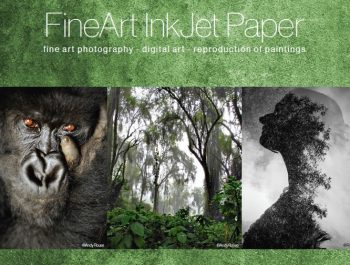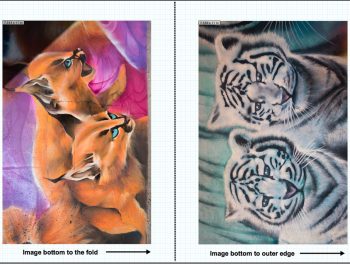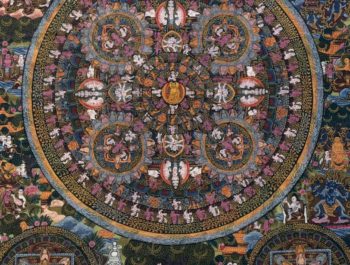Canson Baryta Photographique II
Canson Infinity Baryta Photographique II (CBP2)
Readers who print their photographs on papers containing baryta (barium sulfate) know that starting around November of last year certain favorite brands of this paper started to disappear from the market – Ilford Gold Fibre Silk, Canson Baryta Photographique, Epson Legacy Baryta, Red River San Gabriel Soft Gloss 2 to name the most common that were available on the North American market. It is not unusual in this industry that a number of brands have the paper manufactured in the same facility with minor variations to the basic recipe.
From the “Photospeed” website:
“All baryta inkjet papers are fibre-based (cotton rag or alpha-cellulose) and are made using a special coating of barium sulphate traditionally applied …….. before it’s coated with emulsion. ………… Adding the baryta layer helps to brighten the image and prevents other chemicals absorbed on the fibres from infiltrating the other layers of the paper.”
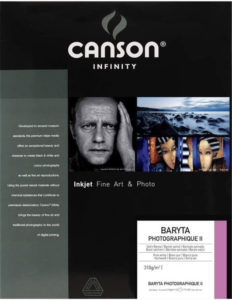 The most credible explanation I’ve been given for the disappearance of the above-mentioned group of papers is that a chemical needed to work with the barium sulfate in this basic recipe became unavailable (though the name of the chemical and the reason for its non-availability remain unknown to me). There are other baryta-containing papers (from Hahnemuehle and Moab for example) made from different recipes that have not experienced this problem and they continue to be available.
The most credible explanation I’ve been given for the disappearance of the above-mentioned group of papers is that a chemical needed to work with the barium sulfate in this basic recipe became unavailable (though the name of the chemical and the reason for its non-availability remain unknown to me). There are other baryta-containing papers (from Hahnemuehle and Moab for example) made from different recipes that have not experienced this problem and they continue to be available.
Meanwhile the affected companies have been working on replacements for their previous baryta-based offerings. Two of those have become available some months ago – CBP2, the subject of this article, and Red River Palo Duro Baryta Fibre 300, which I shall review in a following article.
As well, Moab Juniper Baryta Rag 305 which disappeared for some time due to a supply chain problem, is back on the market. Legion paper advises it is the same as it was. I used this paper as one of the three test papers in my recent article comparing the MYIRO-1 and i1Pro 3 spectrophotometers. It performed well in those tests, so I think I need not review it yet again, as another review would repeat much of the same information appearing in that article. It has a cotton fibre substrate, no OBAs and is a slightly warm tone paper. It is a slightly more textured luster paper than were IGFS or Legacy Baryta.
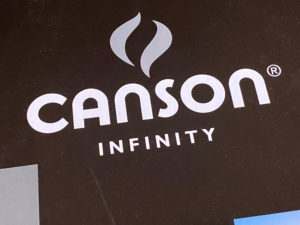 CBP2 is the least textured of the baryta-containing papers I have reviewed – in fact a very lightly textured soft-gloss that will appeal to people who don’t like a shiny gloss coating but also aren’t keen about the luster surfaces with obvious texture. I would call it a “smooth semi-gloss” or “egg-shell” compromise between high gloss and luster. It’s one downside is that you cannot look at prints with this finish from much of an angle – it is more than usually necessary to view them head-on to appreciate their full quality. It has an alpha-cellulose substrate, is acid-free and includes “very low” OBAs content (according to the spec sheet). The paper weight is 310g/m2, thickness 305 um and feels moderately stiff and robust – lots of “body”. This paper definitely has a
CBP2 is the least textured of the baryta-containing papers I have reviewed – in fact a very lightly textured soft-gloss that will appeal to people who don’t like a shiny gloss coating but also aren’t keen about the luster surfaces with obvious texture. I would call it a “smooth semi-gloss” or “egg-shell” compromise between high gloss and luster. It’s one downside is that you cannot look at prints with this finish from much of an angle – it is more than usually necessary to view them head-on to appreciate their full quality. It has an alpha-cellulose substrate, is acid-free and includes “very low” OBAs content (according to the spec sheet). The paper weight is 310g/m2, thickness 305 um and feels moderately stiff and robust – lots of “body”. This paper definitely has a 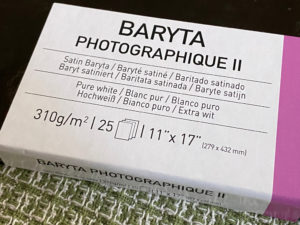 different character from the original Baryta Photographique it replaces. Canson advises two points: (1) the new equipment for coating the Baryta allows them to offer a 60” width and (2) the adhesion of the coating to the substrate is improved relative to original Baryta Photographique, reducing any potential paper surface marking or flaking caused by a dull cutting blade.
different character from the original Baryta Photographique it replaces. Canson advises two points: (1) the new equipment for coating the Baryta allows them to offer a 60” width and (2) the adhesion of the coating to the substrate is improved relative to original Baryta Photographique, reducing any potential paper surface marking or flaking caused by a dull cutting blade.
My usual procedure for a paper review is to examine its printing characteristics through the profiles used for this paper and the printer at hand – in my case now an Epson SC-P5000. This printer and inkset can reproduce the widest colour gamut that inkjet papers are capable of at present time. The technical aspects of the paper’s performance depend on the quality of the paper itself and the profiles used to print with it.
I usually begin with the profile provided by the paper supplier on their website, and then compare with a custom profile that I generate. Canson Infinity, in collaboration with its North American technical partner, profiled this printer/paper combination and I can recommend, based on the numbers, that their profile is very good – in fact inter-changeable with my custom profile. The comparative basic data between their profile and mine is provided in Figure 1.

For both profiles the gamut volumes are very large, and not far enough apart to make a noticeable difference in a print. The custom profile shows a one notch lower White Point and one notch darker Black Point, again nothing that would be seen in most prints. The boundaries of the Red and Blue primaries are similar, the OEM Green boundary being a bit warmer on the a* axis and cooler on the b* axis than the custom profile. As these are boundary conditions, again perhaps no noticeable differences in most prints.
The custom profile is made with the Konica-Minolta MYIRO-1, while the OEM profile was prepared with X-Rite equipment and i1Profiler. As the MYIRO profiles are optimized for dE(2000), I would recommend focusing on those outcomes in rows 20, 21 and 22 of Figure 1. The average dE(2000) for the 48 patches of my main evaluation target and the dE(2000) of the worst performing patch differ little between the two (see all 48 in Figure 2).
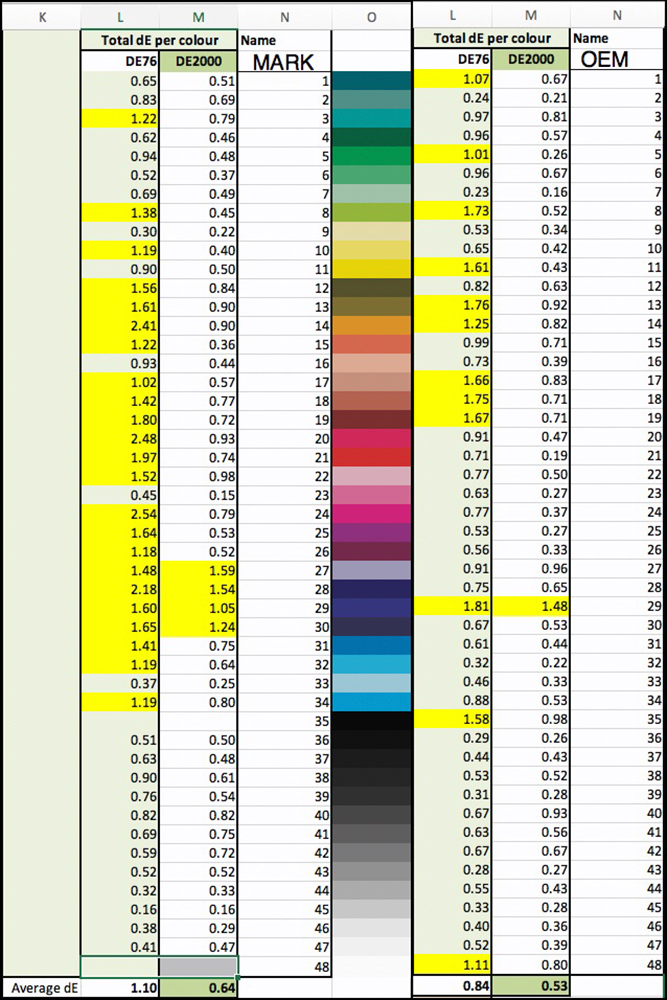
Regarding grayscale linearity and hue neutrality, the grayscale analyses indicate that both profiles perform very well (Figure 1). The average differences between the profiles for linearity and hue neutrality of L*, a* and b*, whether Dark tones, Mid tones or Light tones, are not significant. Figures 3, 4 and 5 provide a more detailed grayscale analysis.
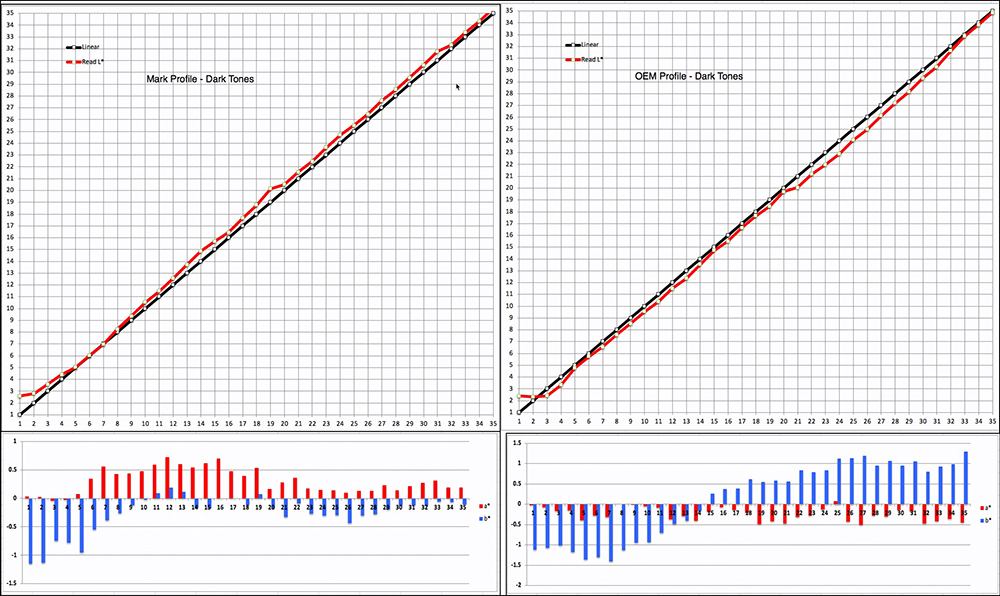
In the upper portions of these graphs, the more closely the Red line (the read values) adheres to the Black line (the reference values), the better the L* linearity and the smoother the expected tonal gradations. In the lower portion of these graphs, the closer are the bars to zero (the horizontal axis), the less hue bias there is. Blue bars are for the yellow-blue axis and red bars are for the red/magenta-green/cyan axis. Values below the axis indicate a blue or green bias. Values above the axis indicate a red or yellow bias. Values below 1.0 should be normally indistinguishable from zero.
For the Dark tones (Figure 3) both profiles pass in respect of both linearity and hue neutrality.
For the Mid-tones (Figures 4) both profiles pass in respect of tone linearity. One would have liked to see a bit less statistical hue bias in the OEM profile, but the extent of it is unlikely to look non-neutral in a print.
For the Light tones (Figure 5) linearity is very good and hue neutrality is on the whole well-preserved.
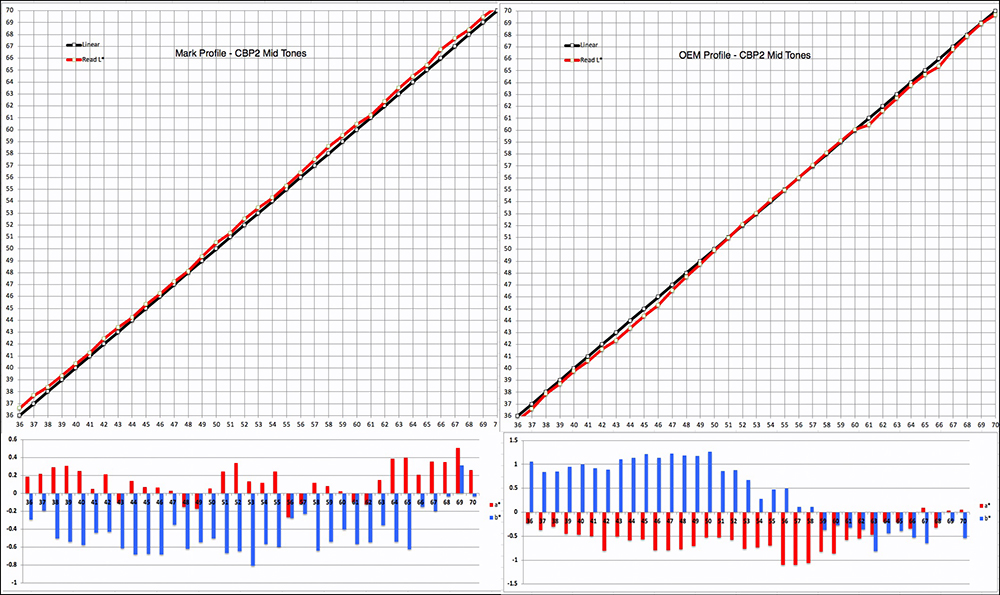

So, from a technical perspective, the paper is fine – very wide gamut and capable of good colour reproduction accuracy. But what do the prints look like? From this information one would expect them to look fine, and indeed they do.
I ran the Atkinson Printer Test page and the BVDM Roman 16 low and high key B&W images with both the Canson profile and my profile. As the two profiles perform so closely, it is only necessary to reproduce one set of these images allowing you to see as best one can over the Internet what the print quality is like (Figures 6, 7 and 8).
From these samples, you can see that colour rendition is very good, tonal gradations are fine, B&W neutrality is well preserved, and highlight and shadow detail are also well preserved. My overall recommendation is that if you like the finish, it’s a very good paper.



In Figure 7 the very good tonal separation within the Dark tones shows well, and in Figure 8, likewise, the very good tonal separation within the Highlights shows well, both contributing to the rendition of good image detail.
Mark D. Segal
September 2020
Toronto, ON
Mark has been making photographs for the past seven decades and started adopting a digital workflow in 1999 first with scanning film, then going fully digital in 2004. He has worked with a considerable range of software, equipment, materials and techniques over the years, accumulated substantial experience as an author, educator and communicator in several fields, was a frequent contributor to the Luminous-Landscape website and now contributes frequently with in-depth articles on the PhotoPXL website. Mark has contributed over 75 articles to the two websites up to Q1-2024, with a particular emphasis on printers and papers, given his view that a photograph printed on paper remains the epitome of fine photography, as it has been from soon after the medium was invented and started gaining momentum in the 1830s/1840s. Mark developed a particular interest in film scanning and authored the ebook “Scanning Workflows with SilverFast 8, SilverFast HDR, Adobe Photoshop Lightroom and Adobe Photoshop” (please check our Store for availability). In his “other life” (the one that pays for the photography), Mark is a retiree from the World Bank Group and was a consultant in electric power development.






